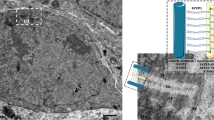Abstract
The whole-mount spreading technique was used to examine the chromosome complement in ten zygotene nuclei of Tradescantia ohiensis var. paludosa. Spread preparations have normal synaptonemal complex (SC) morphology. Neither kinetochores nor recombination nodules were regularly visible. Cloudlike structures (LFSs) 2–6 μm in diameter were sometimes associated with SC and with unsynapsed lateral components (LCs). They differed in number and location in different nuclei. Thickenings of the lateral elements and LCs were observed in mid through late zygotene nuclei. These longitudinal axis thickenings (LATS) were distributed fairly uniformly amongst the chromosomes and occurred in both synapsed and unsynapsed regions. There was a stage-dependent increase in the number and size of LATS. They were nonrandomly distributed along the length of a chromosome, being more frequent in synapsed areas, especially near junctions with unsynapsed regions.
Similar content being viewed by others
References
Carpenter ATC (1979a) Synaptonemal complex and recombination nodules in wild-type Drosophila melanogaster females. Genetics 92:511–541
Carpenter ATC (1979b) Recombination nodules and synaptonemal complex in recombination-defective females of Drosophila melanogaster. Chromosoma 75:259–292
Gillies CB (1973) Ultrastructural analysis of maize pachytene karyotypes by three-dimensional reconstruction of the synaptonemal complexes. Chromosoma 43:145–176
Gillies CB (1975) Synaptonemal complex and chromosome structure. Ann Rev Genet 9:91–109
Gillies CB (1981) Electron microscopy of spread maize pachytene synaptonemal complexes. Chromosoma 83:575–591
Hasenkampf CA (1984a) An ultrastructural examination of chromosoma pairing during meiosis. Dissertation, Florida State University
Hasenkampf CA (1984b) Synaptonemal complex formation in pollen mother cells of Tradescantia. Chromosoma 90:275–284
Hobolth P (1981) Chromosome pairing in allohexaploid wheat var. Chinese Spring. Transformation of multivalents into bivalents, a mechanism for exclusive bivalent formation. Carlsberg Res Commun 46:129–173
Holm PB (1977) Three-dimensional reconstruction of chromosome pairing during the zygotene stage of meiosis in Lilium longi-florum (Thunb). Carlsberg Res Commun 42:103–151
Hotta Y, Stern H (1981) Small nuclear RNA molecules that regulate nuclease accessibility in specific chromatin regions of meiotic cells. Cell 27:309–319
Hotta Y, Bennett MD, Toledo LA, Stem H (1979) Regulation of R-protein and endonuclease activities in meiocytes by homologous pairing. Chromosoma 72:191–201
Kehlhoffner JL, Dietrich J (1983) Synaptonemal complexes and a new type of nuclear polycomplex in three higher plants: Paeonia tenuifolia, P. delawayi and Tradescantia paludosa. Chromosoma 88:164–170
Maguire M (1978) Evidence for separate genetic control of crossing-over and chiasma maintenance. Chromosoma 65:173–183
Moens PB (1968) The structure and function of the synaptinemal complex in Lilium longiflorum sporocytes. Chromosoma 23:418–451
Moses MJ (1968) Synaptonemal Complex. Ann Rev Genet 2:363–412
Rattner JB, Goldsmith M, Hamkalo BA (1980) Chromatin organization during meiotic prophase of Bombyx mori. Chromosoma 79:215–224
Stack S (1982) Two-dimensional spreads of synaptonemal complexes from solanaceous plants. I. The technique. Stain Technol 57:265–272
Westergaard M, von Wettstein D (1972) The synaptonemal complex. Ann Rev Genet 6:71–110
Author information
Authors and Affiliations
Rights and permissions
About this article
Cite this article
Hasenkampf, C.A. Longitudinal axis thickenings in whole-mount spreads of synaptonemal complexes from Tradescantia . Chromosoma 90, 285–288 (1984). https://doi.org/10.1007/BF00287036
Received:
Issue Date:
DOI: https://doi.org/10.1007/BF00287036




